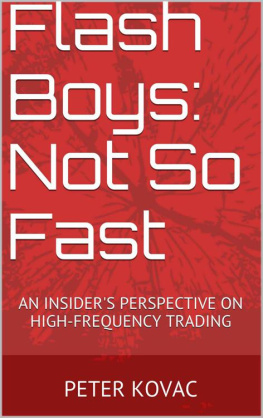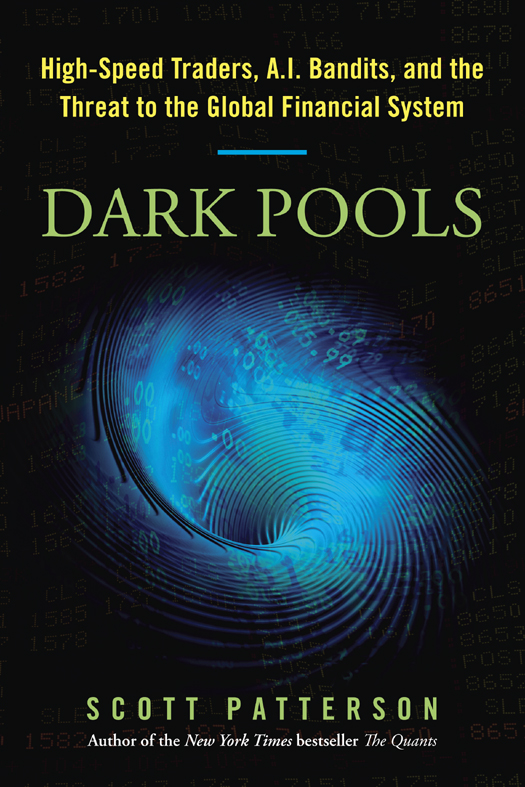A LSO BY S COTT P ATTERSON
THE QUANTS
How a New Breed of Math Whizzes Conquered
Wall Street and Nearly Destroyed It
Copyright 2012 by Scott Patterson
All rights reserved.
Published in the United States by Crown Business, an imprint of the Crown Publishing Group, a division of Random House, Inc., New York.
www.crownpublishing.com
CROWN BUSINESS is a trademark and CROWN and the Rising Sun colophon are registered trademarks of Random House, Inc.
Library of Congress Cataloging-in-Publication Data
Patterson, Scott, 1969.
Dark pools : high-speed traders, AI bandits, and the threat to the global financial system / by Scott Patterson. 1st ed.
p. cm.
1. Electronic trading of securities. 2. Online stockbrokers. I. Title.
HG4515.95.P284 2012
332.640973dc23 2012003096
eISBN: 978-0-307-88719-1
Jacket design by Laura Duffy
Jacket photography: (swirl) Design Pics/Ryan Briscall;
(numbers) Mark Segal
v3.1
For Eleanor
Had there been full disclosure of what was being done in furtherance of these schemes, they could not long have survived the fierce light of publicity and criticism. Legal chicanery and pitch darkness were the bankers stoutest allies.
F ERDINAND P ECORA
CONTENTS
PROLOGUE
LIGHT POOL
L oudspeakers boomed Eminems hit single Without Me as Dan Mathisson stepped onto a low-slung dais in the Glitter Room of Miami Beachs exclusive Fontainebleau Hotel. Greeting Mathisson: the applause of hundreds of hedge fund managers, electronic traders, and computer programmers, the driving force behind a digital revolution that had radically transformed the United States stock market. They had descended on the Fontainebleau for the annual Credit Suisse Equity Trading Forum to rub elbows, play golf, swap rumors, and bask in the faded glory of the hotel where stars such as Frank Sinatra, Elvis Presley, and Marlene Dietrich had once sipped cocktails and lounged in private poolside cabanas.
Smartly clad in a light blue cotton shirt and charcoal-gray suit, sans tie, a soft pink Credit Suisse logo illuminated on the wall behind him, Mathisson was pumped. He loved the Miami Beach conference. Over the years, it had become the Woodstock of electronic trading. Closed to the press, the March 10, 2011, gathering was a private congress of wealthy market wonks whod created a fantastic Blade Runner trading world few outsiders could imagine, a worldwide matrix of dazzlingly complex algorithms, interlinked computer hubs the size of football fields, and high-octane trading robots guided by the latest advances in artificial intelligence.
Mathisson was an alpha male of the electronic pack. In another life, the bespectacled five-seven onetime trader would have been teaching students quantum physics or working for Mission Control at NASA. Instead, starting in 2001, hed devoted himself to building a space-age trading platform for Credit Suisse called Advanced Electronic Systems. He was an elite market Plumber, an architect not of trading strategies or moneymaking schemes but of the pipes connecting the various pieces of the market and forming a massive computerized trading grid.
Plumbers such as Mathisson had become incredibly powerful in recent years. Knowledge of the blueprints behind the markets plumbing had become extremely valuable, worth hundreds of millions of dollars to those in the know. The reason: A new breed of trader had emerged who focused on gaming the plumbing itself, exploiting complex loopholes and quirks inside the blueprints like card counters ferreting out weaknesses in a blackjack dealers hand.
Mathisson was keenly aware of this. Since launching AES, hed been a firsthand witness of the powerful computer-driven forces that had irrevocably altered the face of the stock market. Hed created AESs original matching enginethe computer system that matched buy and sell orderswhich by early 2011 accounted for a whopping 14 percent of U.S. stock-trading volume, nearly one billion shares a day. He was the brains behind Guerilla, the first mass-marketed robot-trading algorithm that could deftly buy and sell stocks in ways that evaded the detection of other algos, a lethal weapon in the outbreak of what became known as the Algo Wars.
Operating in forty countries across six continents, AES was a moneymaking machine. In 2008, a year when most of Wall Street was single-mindedly engaged in the act of self-destructing, AES had pulled in about $800 million, making it the most profitable arm of Credit Suisse. That numberthat $800 millionwas just one reason among many why Mathissons words on that Miami Beach stage meant serious business.
But while the Miami confabs had always been about business, they were also about celebrating, and they typically involved a conga line of cocktail parties, pool parties, and dance clubs. In years past, after the days long string of speeches and presentations, Mathissons right-hand man, a charismatic, larger-than-life sales machine named Manny Santayana, would troll the local clubs, pick out the best-looking local girls, and tell them about the real party packed with millionaire traders looking for a good time.
Santayana always joked that he never threw parties. He threw networking events at a socially accelerated pace. Santayana was king of the socially accelerated pace. He ran poker tournaments for traders in the exclusive Grand Havana Room in Manhattan, dinners for bankers at the Versace Mansion in Miami Beach. All year long, there were networking events at a socially accelerated pace around the worldin Tokyo, Singapore, Zurich, London, Oslo, Paris, Hong Kong.
But an iron rule on Wall Street is that every party leads to the inevitable hangover. As Mathisson looked out over the audience, he knew Santayana wouldnt be trolling clubs for bleach-blond babes this year. A freakish stock market crash on May 6, 2010the so-called Flash Crashhad revealed that the computer-driven market was far more dangerous than anyone had realized. Regulators were angry, fund managers furious. Something had gone dramatically wrong. Senators were banging down Mathissons door wanting to know what the hell was going on. A harsh light was shining on an industry that had grown in the shadows.
Mathisson was ready to confront the attack. He hit a button on the remote for his PowerPoint presentation. A graph appeared. A jagged line took a cliff-like plunge followed by a sharp vertical leap. It looked like a tilted V, the far right-hand side just lower than the left.
Theres the Flash Crash, he said. We all remember that day, of course.
The chart showed the Dow Jones Industrial Average, which took an eight-hundred-point swan dive in a matter of minutes on May 6 due to glitches deep in the plumbing of the nations computer-trading systemsthe very systems built and run by many of the people sitting in the Glitter Room.
The audience stirred. The Flash Crash was a downer, and they were restless. It was going to be a long day full of presentations. Later that night, theyd be treated to a speech by the Right Honorable Gordon Brown, former prime minister of the United Kingdom. ExClinton aide James Carville would address the group the following morning. (It was nothing unusual. Past keynote speakers at the conference had included luminaries such as former Federal Reserve chairman Alan Greenspan, former secretary of state Colin Powell, and the onetime junk-bond king Michael Milken.)


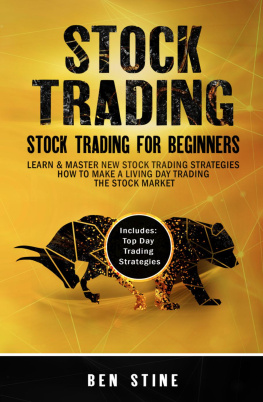
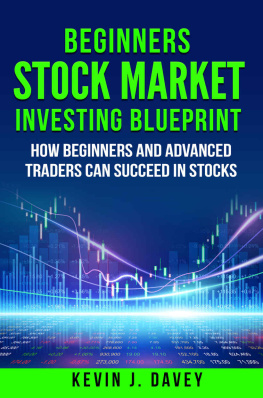
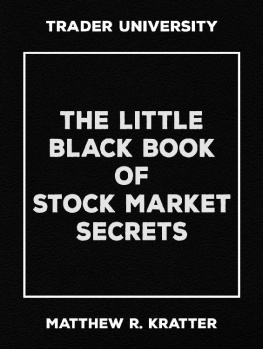
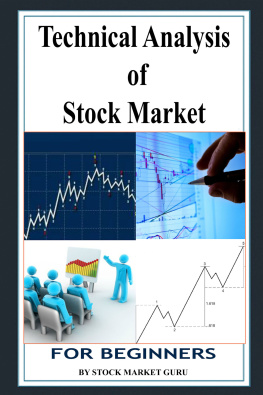
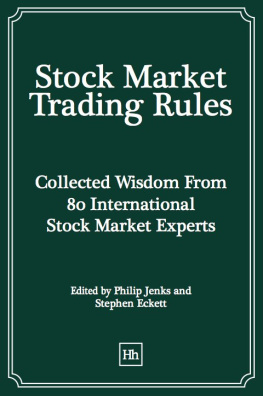
![Ryan Mallory [Ryan Mallory] - The Part-Time Trader: Trading Stock as a Part-Time Venture, + Website](/uploads/posts/book/124134/thumbs/ryan-mallory-ryan-mallory-the-part-time-trader.jpg)
